By Eric Vandenbroeck and co-workers
Queen Elizabeth and the limitations of
monarchy in the world
Can the hereditary
principle that underpins monarchy survive now that its most distinguished,
respected, and popular modern incumbent is gone? For decades, the queen was the
elderly holder of an even more ancient office, which made a certain sense. The
pomp and ceremony that surrounded the British monarchy—from the queen’s
archaically uniformed so-called Beefeaters and guardsmen to the horse-drawn
carriages and vintage Rolls-Royces she traveled in—were as many relics of a
glorious imperial past as Elizabeth was herself.
There are few points
of comparison for a head of state who remains in office for seven decades. In
June 2022, Queen Elizabeth II, who died on September 8, surpassed even
Thailand’s King Bhumibol Adulyadej to become the longest-reigning monarch in
the industrial era. Only Louis XIV of France, who ruled for 72 years in the
seventeenth and early eighteenth centuries, spent more time on the throne. All
the more remarkable, during these decades as sovereign, she weathered
extraordinary upheavals in British foreign policy—from decolonization to the
war on terror, from the rise of the European Union to Brexit—that few could
have anticipated when she became queen in 1952.
But the queen’s reign
was as distinctive for its geographical scope as its chronological span. At her
death, the queen ruled over 15 so-called realms, including Canada, Australia,
New Zealand, the United Kingdom, and a handful of countries in the Caribbean
and the Pacific—the remaining parts
of the Commonwealth
of Nations, or simply the British Commonwealth, that had retained her as their
sovereign. Throughout her reign, she had also been head of state of 32
independent countries across the globe. In 2021, Barbados joined 16 other
states, including Ceylon, Ghana, Pakistan, and Trinidad and Tobago, which
during her reign spent a period as independent Commonwealth realms before
making the transition to republics.
These changes are
symptomatic of the tectonic shifts in the United Kingdom’s geopolitical status
under her watch. In 1952, the country was still basking in the afterglow of its
moral and military triumph in World War II. Queen Elizabeth was surrounded at
her coronation by her first prime minister, Winston Churchill, and other
architects of the Allied victory over Nazi Germany. She hubristically hoped her
reign would usher in a new era of British global leadership. Over the next two
decades, the opposite would happen: the United Kingdom lost most of what
remained of an empire that, at its height, covered a quarter of the earth’s
surface. With an economy devastated by war, it struggled to pay for its
worldwide defense commitments and defend the pound sterling as a leading
international currency. The United Kingdom was increasingly relegated to a
supporting role in a superpower struggle between the United States and the
Soviet Union. It seemed uncertain whether its future lay with Europe or the
Atlantic alliance.
But then there was
the Commonwealth. To most observers, this loose organization was little more
than the faint impression left on the globe after the British Empire dissolved.
Its history was more complicated and its function more significant. For the
queen, the Commonwealth gradually became a defining mission, a way for the
United Kingdom to reassert its influence and leadership in the face of
decolonization and diminished military and economic power. At its best,
the Commonwealth served to shape and even amplify British foreign policy. Among
the challenges now facing King Charles III is helping to secure the survival of
this entity at a time when the monarchy itself, even as a symbol, appears
increasingly anachronistic.
Political change, palace preservation
To many observers,
the queen’s affection for, and frequent championing of, the Commonwealth was
slightly curious. Apart from members of the Commonwealth’s various governmental
and non-governmental organizations, the queen was one of the few people who
casually slipped the word “commonwealth” into a sentence, as though it had a
prominent physical presence in the world, like a bank or a grocery store. To
most people, the Commonwealth was barely visible, if at all. To understand her
attachment to it, it is necessary to look more closely at how the entity
developed and the House of Windsor’s pivotal role in the British Empire that
preceded it.
The United Kingdom’s
imperial legacy shaped Elizabeth’s rule from the start. Commentators have
repeatedly referred, for example, to the pledge of service she made to the
nation in a broadcast from South Africa on her 21st birthday in 1947. The
precise words she used are worth recalling. She promised listeners: “My whole
life, whether long or short, shall be devoted to your service and the service
of our great Imperial family to which we all belong.” As the historian
David Edgerton has recently argued, the United Kingdom did not acquire the full
trappings of a modern nation until the second half of the twentieth century.
Before that, it was essentially the core of an empire: the royal family was at
its apex and reflecting the class-bound nature of British society, London
envisaged the empire in strictly hierarchical terms. When the queen’s
coronation was being planned, the Colonial Office was asked to rank in order of
precedence all 300 guests to Westminster Abbey from the colonial territories.
At that point, although the United Kingdom had already relinquished its South
Asian empire, British officials still expected that most of the remaining
colonial territories would stay under British control for decades. When it
quickly became clear that this would not happen, the queen needed a new way to
sustain the royal family’s central role in the British state. The Commonwealth
provided an appealing answer.
Diplomats came up
with a formula that allowed India to remain in the Commonwealth as a republic,
thus removing the one factor that had hitherto bound member states together:
common allegiance to the crown. The agreement entailed India recognizing George
VI not as its sovereign but in the ill-defined role of “head of the
Commonwealth.”
For Queen Elizabeth,
who ascended the throne three years later, this agreement would be a means to
modernize the monarchy. In contrast to her father, who bitterly regretted the
loss of his title of emperor of India, she enthusiastically embraced the advent
of the “new” Commonwealth ushered in by Indian independence. Buckingham Palace
kept a healthy distance from the futile efforts of British Prime Minister
Anthony Eden, who sought to topple Egypt’s General Abdel Nasser during the Suez
Crisis of 1956 and thus end his anticolonial influence in Africa and the Middle
East. And the queen made clear that she did not resent the political forces
that pushed British colonies in Africa and the Caribbean to seek independence
in the 1960s and 1970s. She seems to have fully subscribed to the “official” explanation
that this process was the natural outcome of enlightened British tutelage (even
though, early in her reign, the United Kingdom had conducted brutal
counterinsurgency campaigns in Cyprus, Kenya, and Malaya).
When arriving in Jamaica,
the Duke and Duchess of Cambridge were accused of benefiting from the “blood,
tears, and sweat” of slaves. They arrived in Jamaica and were met
by a protest calling for reparations from the British monarchy.
Earlier the monarchy
was not even inclined to fight a rear-guard action to dissuade countries that
had become independent as “realms” from making the further transition to
republics. In recent years, many analysts have speculated about what would
happen in the remaining realms when the queen died. But change was already
afoot in the Caribbean in the final years of her reign, with Barbados’s
decision to renounce the monarchy and become a republic in 2021. Antigua and
Barbuda, the Bahamas, Belize, and Jamaica seem likely to follow. Yet throughout
the queen’s reign, the palace has always been adamant that as a constitutional
monarch, she could not be embarrassed by political changes in her realms so
long as they took place by constitutional means. What mattered to her was that
they remained a part of the Commonwealth. In this light, Charles’s visit to
Barbados to represent her at the ceremony marking the country’s transition to a
republic was a powerful signal of continuity.
Less empire, more friends
Most notably, the
queen turned the title of head of the Commonwealth—an abstract diplomatic
construct created to keep a democratic India loosely in the British orbit—into
something far more tangible. She did so by a steady series of gradual
accretions throughout her reign: she visited almost all the Commonwealth’s
member states; supported the Commonwealth Games and the annual
Commonwealth Day service in Westminster Abbey; attended countless meetings with
heads of government; and even made a royal palace, Marlborough House, available
to the Commonwealth as its headquarters. She also augmented the conventional
diplomatic role of European monarchs—participating in inward and outward state
visits—by cultivating warm personal relations with many Commonwealth leaders,
which sometimes stretched over generations. In doing so, she eased the process
of losing an empire for the United Kingdom and won it with friends worldwide.
However, the Queen’s
courtiers banned “coloured immigrants or
foreigners” from serving in clerical roles in the royal household until at
least the late 1960s.
Illustration underneath courtesy of The Guardian:
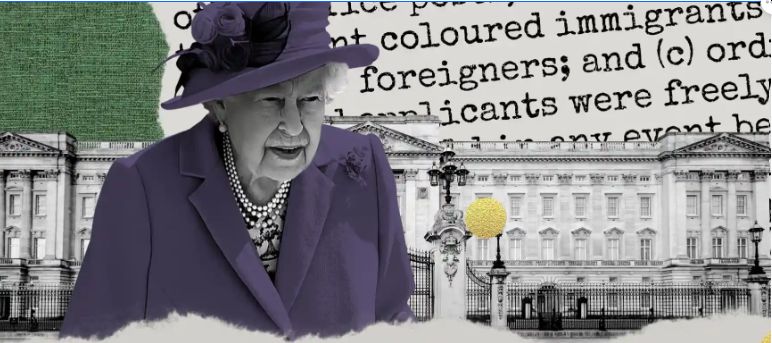
Some of her
diplomatic achievements were noteworthy. The crusade against South African
apartheid was a signature issue for the Commonwealth in the 1970s and 1980s,
and the queen sometimes appeared more inclined to side with many member states
than with her prime ministers. Some of them seemed unduly close to the South
African government. When, in 1986, a boycott of the Commonwealth Games was
threatened by countries who disapproved of Prime Minister Margaret Thatcher’s
opposition to economic sanctions against South Africa, the queen’s press
secretary briefed The Sunday Times about the queen’s concerns
about Thatcher, in what appeared to be a signal to the rest of the Commonwealth
that the queen was on their side. Since the British Empire turned Commonwealth
was by its nature multiethnic, multicultural, and multireligious, the queen
sought to emulate that diversity at home. By making a point of meeting
community and religious groups from the country’s ethnic minorities—she was the
first British monarch to visit a mosque in the United Kingdom—she strove to
make the United Kingdom a more welcoming place for newcomers, as mass immigration
from the Commonwealth gathered pace from in the second half of the twentieth
century.
People read a local newspaper reporting the death of
Queen Elizabeth II in Nairobi, Kenya.
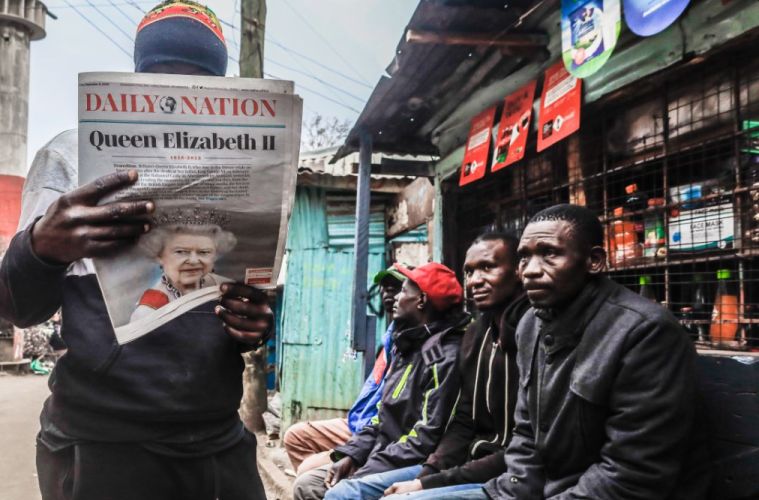
But the queen could
not escape the larger reality that, particularly in later decades, the
Commonwealth did not have a clearly defined political purpose. Ironically,
although it was a victory for the Commonwealth, the advent of majority rule in
South Africa in the 1990s robbed it of the issue that had given it
international diplomatic prominence. At the same time, the end of the
Cold War meant that the Commonwealth lost its value as a way for the British
government to keep open, friendly communication channels with countries that
might have been in danger of coming under Soviet influence. In recent years,
attempts to reinvent the Commonwealth as a values-based” organization have
faltered, not least because many member states have fallen far short of the
Commonwealth’s purported standards on democracy and human rights issues. Poor
leadership and growing doubts about the value of the organization’s activities
have meant that, increasingly, it has only tended to be regarded as newsworthy
if a story about it has a royal angle. Since the 1990s, the monarchy has
increasingly seemed like a life-support system for the Commonwealth, hence the
decision in 2018 to name Charles as its next head. If the organization
collapses, it will be despite the queen’s best efforts.
In 2007, she met with
one of Africa's longest-serving presidents, Yoweri Museveni, who has been in
power since 1986 as seen below:
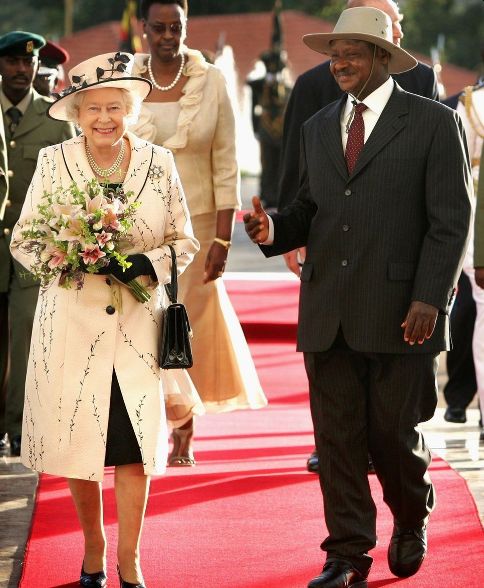
In her support for
the Commonwealth, the queen showed her considerable skill in reinventing the
monarchy for a postimperial world. Yet in doing so, she also showed the
limitations of royal influence. Perhaps by its nature, a monarchy is not the
best constitutional framework for encouraging a more egalitarian society.
Although the United Kingdom is far less stratified than it was 70 years ago, it
remains deeply divided. An arguably more significant problem lay in the queen’s
tendency to present the United Kingdom’s relations with Commonwealth member
states as a universal good while making no similarly sustained personal effort
to reconcile the country to its membership in the European Union. This was
despite the strong links between the royal family and Europe, and the queen
herself spoke fluent French, her husband fluent German. Of course, British
membership in the EU was politically contentious. But so, for periods of her
reign, was the persistence of the Commonwealth. The queen remained properly
neutral during the 2016 Brexit referendum, despite the attempts of some
tabloids to draw her in. But by then, arguably, popular opinion had been allowed
to drift for too long.
It is a further irony
that Brexit may lead to the breakup of another entity
close to the queen’s heart: the Union of the United Kingdom. The divorce from
Brussels has given fresh momentum to the Scottish independence movement. (A
majority of Scots voted against leaving the EU.) It has also created a new EU
border across Ireland, leading to a special status for Northern Ireland that
may, in turn, encourage closer integration of the island’s north and south—and,
ultimately, reunification between Belfast and Dublin. But if the British public
begins to feel remorse over the decision to leave the EU, the blame can hardly
be said to lie with the queen. In almost every respect, she was a textbook case
of what a constitutional monarch should be in both domestic and international
affairs: above party politics.
But
while Elizabeth II was a pillar of stability in tumultuous times. Her
successor will need to adapt while also protecting the age-old magic of the
monarchy.
King Charles III faces challenges as old colonial
links go
Can the hereditary
principle that underpins monarchy survive now that its most distinguished,
respected, and popular modern incumbent is gone? For decades, the queen was the
elderly holder of an even more ancient office, which made a certain sense. The
pomp and ceremony surrounded the British monarchy—from the queen’s archaically
uniformed so-called Beefeaters and guardsmen to the horse-drawn carriages and
vintage Rolls-Royces.
The U.S., U.K.,
Australia, and India each fall under the umbrella of
the common law family, although the legal tradition of each maintains unique
aspects. Ironically, Queen Elisabet's death on
September 8 came just a few hours after India, a leading member of what was
once called the “British Commonwealth,” began erasing some of the last
emblems of British colonialism from central Delhi.
Erasing what Prime
Minister Narendra Modi called a “symbol of slavery,” the name of Delhi’s
revamped ceremonial road from the presidential palace to India Gate was changed
from Rajpath to Kartavya Path, which means Path of
Duty. It had been called Kings Way before independence, and Modi said at the
renaming ceremony on September 7 that both the old names “symbolized the power
of the ruler.”
This is not a move against the UK or the Commonwealth
but about removing the relics of British rule as India’s modern history is
rewritten to shift Jawaharlal Nehru (and Mahatma Gandhi) from their revered
positions as the primary independence heroes. Modi wants to be seen as India’s
pre-eminent post-1947 leader and to eliminate the Nehru-Gandhi dynasty’s
already fading Congress Party.
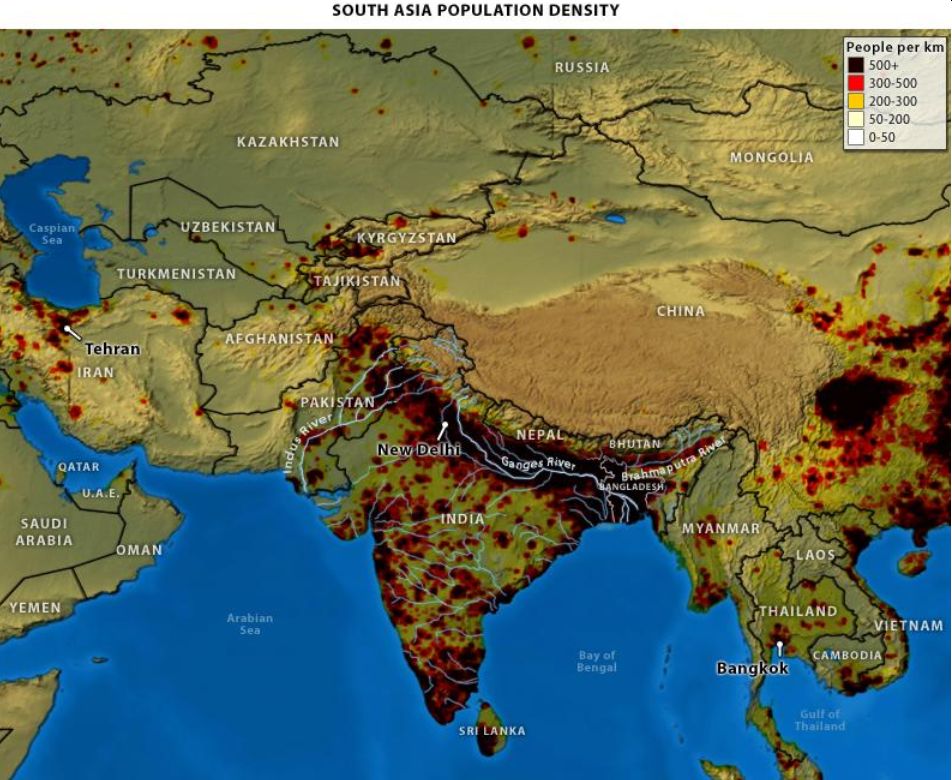
The new hero of independence is Netaji Subhas Chandra
Bose, a political leader who sided with the Japanese in World War II as a move
against the British. His 28-ft statue was unveiled this past week on Kartavya Path under a Grand Canopy that used to cover a
statue of King George V.
“At the time of slavery, there was a statue of the
representative of the British Raj. Today, the country has also brought to life
a modern, strong India by establishing the statue of Netaji at the same place,”
said Modi. The Indian Navy has also dropped the red cross of St George in a new
version of its ensign (it was also dropped earlier, then restored).
When Elizabeth
succeeded her father, King George VI in 1952, she became head of state of more
than 30 countries or realms as they are known in Commonwealth parlance. While
she was Queen, 17 replaced her with their own heads of state, and many of the
remaining 14, including Canada and Australia, are likely to do so too.
In 1952, India was
the only country in Britain’s old empire that was not only independent (from
1947) but had also become a republic (in 1950). Jawaharlal Nehru, the country’s
prime minister, initiated moves that ensured the Queen immediately inherited
the role as head of the Commonwealth.
In 2018, when the biennial Commonwealth summit (known
as Chogm) was held in London, Modi is believed to
have also played a significant role in ensuring that the then Prince Charles,
who had visited him in Delhi for dinner a few months earlier, was adopted as
the future leader. In hindsight, achieving this smooth succession was the
Queen’s primary aim for the summit.
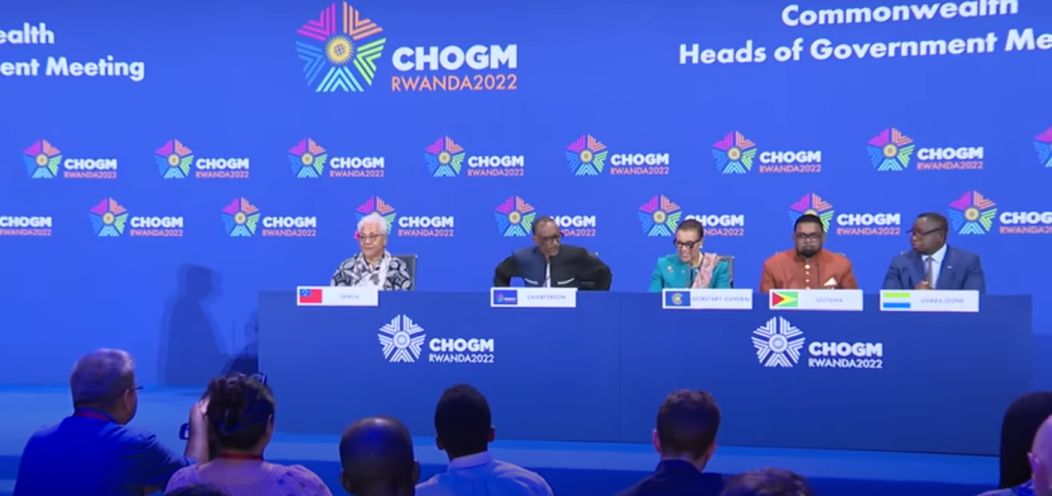
Questions at a Chogm press
conference about whether there had been any objections to Prince Charles
drew answers indicating that not all the countries had initially agreed. The
Ghana president, Nana Akufo-Addo, said there was “a strong consensus.” Theresa
May, the British prime minister, said it was “unanimous,” which, of course, did
not mean there were not any dissenters during the discussions.
Earlier suggestions
that the role could rotate around the realms did not have much support, and
there was no other international figure of sufficient stature. The decision
could have been delayed, but the British government and royal family lobbied
effectively against that happening.
The frictions King
Charles will face were illustrated when the Duke of Cambridge, now the Prince
of Wales,
toured the Caribbean in March. Barbados had replaced the Queen with an
elected president four months earlier, and the Jamaican prime minister publicly
told the duke and duchess that his country too would be “moving on”.
Reparations for the slave trade under British rule were demanded in the
Bahamas.
It looked like the
British foreign ministry had not adequately discovered and prepared for what
would emerge. The duke said the tour had “brought into even sharper focus
questions about the past and the future.”
Who the Commonwealth
chose as a leader “wasn’t on my mind,” he added, thinking ahead to when he
becomes king and the question of him succeeding his father will arise. “What
matters to us is the potential the Commonwealth family has to create a better
future for the people who form it.”
The Commonwealth has
never emerged as a major internationally significant or influential institution
and is widely regarded as a waste of time and money. Even Narendra Modi seemed
to lose interest after the 2018 Chogm and didn’t
attend this year’s summit in Rwanda. In 2018, there was an idea that India should
play more of a leadership role, but that has not developed, even though the
Commonwealth has the advantage of being a rare international organization where
China doesn’t qualify for membership.
As an organization,
it is most valued by over 30 small states with populations under 1.5million.
They see it as a forum where they can meet and mix with world leaders and where
they can also find a voice and call on expert advice and support. On a
different level, there are valuable events like the Commonwealth Games and many
associated organizations dealing with issues from human rights to climate
change.
Sunday (Sept 11) has
been declared an official day of mourning in India, and the Queen is revered in
most other countries. There are exceptions; however, notably, it seems in
Africa that there have been reports (including here
on CNN) that she doesn’t deserve
to be mourned because she was sovereign during the repression of the Kenyan Mau
Mau rebellion in the 1950s.
But the monarch has less power than many other heads of state and is not
supposed to intervene – something the new king might find challenging, given
his record of speaking out, especially on climate change and the environment.
Referring to the
Queen, the Round Table said, “Although her role necessitated
discretion and is shrouded in secrecy, it is well known that on several
occasions (such as on the question of sanctions against the apartheid regime in
South Africa) she fought the Commonwealth’s corner with her then UK prime
ministers,”. She also dropped a gentle hint against an independence vote when
Scotland had a referendum in 2014.
That is the challenge facing the new King – finding a
way to fill the role performed with tact and skill by his mother so that he is
accepted as the leader and then holds the Commonwealth together as individual
countries like India determinedly sever relics of the colonial rule. In
contrast, others become republics and removed him as head of state.
For updates click hompage here